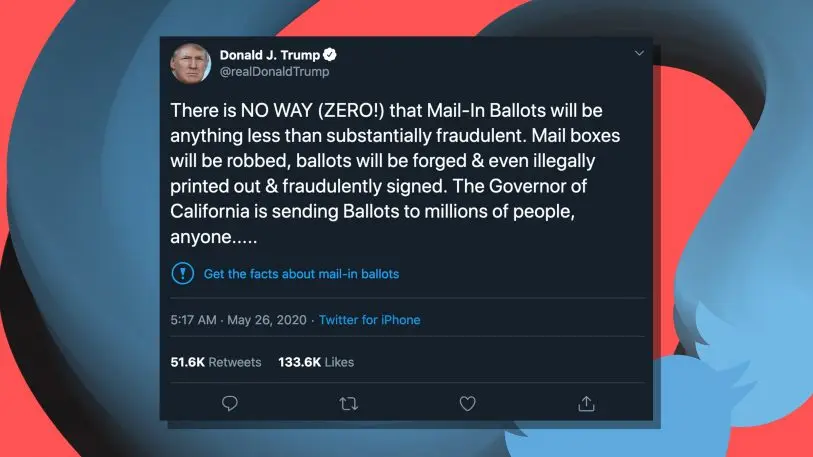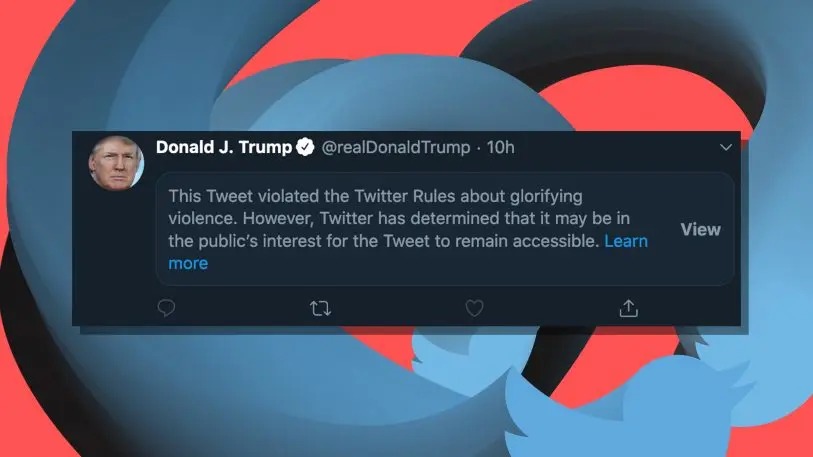For the past four years, Trump has enjoyed free rein on Twitter. Any musing, however racist or threatening, has been treated with diplomatic immunity. Trump has said things on Twitter that would get any normal citizen banned from the service. And yet Twitter let Trump go . . . until this week.
That’s when Twitter employed the smallest of design interventions against Trump’s propaganda machine, and in response, Trump is trying to shut down the law that makes Twitter’s very existence possible.
But within this spectacle, we shouldn’t overlook a simple truth of the matter: Twitter could have done a lot worse to Trump’s messages. Of course he could have been outright banned for his behavior on the network years ago, and his tweets could have been deleted. However, even within the narrower constraints of Twitter’s UI design, the company could have taken more aggressive steps to actually censor, dispute, or even mock the president if it so chose. And it didn’t.
Mr. Trump, Twitter is going easy on you. Really.
What happened?
It all started when, earlier this week, Trump said mail-in ballots (expected during this COVID-19 election era) would be “substantially fraudulent.” Then, with six tiny words, “Get the facts about mail-in ballots,” Twitter fact-checked our president for the first time.


So Twitter went one step further. Citing its policy against the “glorification of violence,” Twitter hid the tweet from Trump’s timeline. It’s still on Twitter here, because, as the company explains, it’s part of important political discourse. You can even RT it with a comment! But your retweet still won’t show Trump’s original tweet. Instead, Twitter puts a warning message in its place. “This Tweet violated the Twitter Rules about glorifying violence. However, Twitter has determined that it may be in the public’s interest for the Tweet to remain accessible.” If you want to actually read the tweet, you have to hit the grayed out “View” beside that message.
In response, Trump has doubled down—on Twitter!—arguing, and retweeting those arguing, for the repeal of Section 230. This federal law passed in 1996, and it allows internet platforms to operate with less liability, by not being held responsible for what’s said on their platforms as a publication like Fast Company would be.
Put aside the fact that Section 230 actually protects a lot of pro-Trump messaging across the internet (and liberals like Nancy Pelosi don’t necessarily love this law either), and you can see Twitter’s move for what it is: white-glove treatment of Trump. Because Twitter could leverage the design of its own platform against Trump’s messaging much more overtly, if it so chose.
What could be different about Twitter’s design intervention?
Take the flag Twitter used on that Trump ballot tweet: “Get the facts about mail-in ballots.” This is one line of text, six words with an exclamation point icon in front that don’t go so far as to actually say “the above message is demonstrably false.” The message is actually hard to notice because the text is rendered in a substantially smaller font size than the tweet itself. It’s the visual equivalent of Trump shouting at a teleprompter, and an intern in the back of the room whispering, “sir, that message may need a correction.”
Consider for a moment all of the other designs Twitter could have chosen. It could have used a strike-through, crossing out Trump’s message to nullify it, but leaving it legible for people to read. It could have blurred the words, so you couldn’t read them at all, but you’d know a tweet was there. Twitter could have blacked them out, in a redaction that’s been used for decades by our own government when it wants to obfuscate the content of documents for all sorts of reasons. Heck, Twitter could choose to put dunce caps on all factually inaccurate tweets! (Actually . . . maybe that’s a good idea?)

But no, Twitter went easy on the president. Maybe not as easy as Facebook does, mind you, but it didn’t use any of the obvious design techniques that you’d use if you were trying to silence, censor, or even overtly correct someone in order to be sure that anyone reading that message would know it was false.
When Trump doubled down later in the week, as he quoted history to bless attacks on African American protesters, yes, Twitter used another tool of design. Again, it didn’t censor our president. Instead, it added a few steps of what designers call “friction,” to slow users down, and ensure that the message was half a step harder to view and share.
In reality, Twitter could have gone farther if it really intended to silence the president or even his supporters. To say nothing of removing the tweet entirely (which did break its terms of service, after all), it could have fully removed the retweet button from Trump’s message—leaving the tweet live but making it impossible to endorse or amplify. On the contrary, it enabled a retweet, but only with comment (your personal, accountable endorsement or criticism), and only with Trump’s message hidden behind a view button. These are the slightest of speed bumps, intended to slow down the viral public discourse by all of three seconds—but not stop it.
Yes, Trump will surely continue rambling on about Section 230, and how Twitter—the platform that’s amplified his voice more than maybe any other—has chosen to censor the American right of free speech. But the truth is, if Twitter wanted to silence Trump, it could silence Trump.
Mr. Trump, Twitter is going easy on you. The proper tweet is, “thank you.”
Recognize your brand's excellence by applying to this year's Brands That Matters Awards before the early-rate deadline, May 3.
